Chapter 11 Notes - Meiosis and Genetics
}}11-1 Chromosomes and Meiosis}}
The specialized cells in your body can be divided into two major groups:
somatic cells - (body cells) make up most of your body tissues and organs
- DNA in your body cells is not passed on to your offspring
gametes - (sex cells) germ cells in your reproductive organs that develop into eggs or sperm
- can be passed on to your offspring
Each species has a characteristic number of chromosomes per cell
- typically given for body cells, not gametes
- chromosome number does not affect complexity of an organism
- eg. yeast have 32 chromosomes (16 pairs), fruit flies have 8 (4 pairs), ferns have the most (more than 1200), each body cell has 46 chromosomes (23 pairs)
- these cells are genetically identical to each other
homologous chromosomes - each pair of chromosomes in your cells
- have the same structure
- 2 chromosomes that have the same length and general appearance - 1 inherited from mother, 1 from father
autosomes - chromosomes pairs 1-22 collectively
sex chromosomes - pair 23, controls the development of sexual characteristics
- XX chromosomes - female
- XY - male
- X and Y pair but are not homologous — the X chromosome is larger and contains numerous genes
fertilization - the actual fusion of an egg and a sperm cell
diploid cells - body cells; have 2 copies of each chromosome (pairs) — one from mother and one from father
- in humans, the diploid number is 46
- represented by 2n
haploid cells - gametes; they have one copy of each chromosome
- in humans, the haploid number is 23
- represented by n
- egg - X chromosome; sperm - chromosome can be X or Y
%%Meiosis%% - a form of nuclear division that divides a diploid cell into haploid cells
- essential for sexual reproduction
- makes genetically unique haploid cells from a diploid cell
- these haploid cells then undergo more processing to form mature gametes
}}11-2 Process of Meiosis}}
Meiosis - a form of nuclear division that creates 4 haploid cells from 1 diploid cell
- involves 2 rounds - meiosis I and meiosis II
- each round has 4 phases (similar to those in mitosis)
- homologous chromosomes are very similar to each other
- same length and carry same genes
- not copies of each other
- homologous chromosomes are divided in meiosis I
- sister chromatids are divided in meiosis II
Before meiosis, DNA has already been copied during the S phase of interphase
%%Meiosis I%% - divides homologous chromosomes, producing 2 haploid cells with duplicated chromosomes
- %%Prophase I%% - nuclear membrane and nucleolus breaks down, centrioles move to opposite sides of the cell, spindle fibers assemble
- duplicated chromosomes condense and homologous chromosomes pair up forming tetrads (four)
- visual:
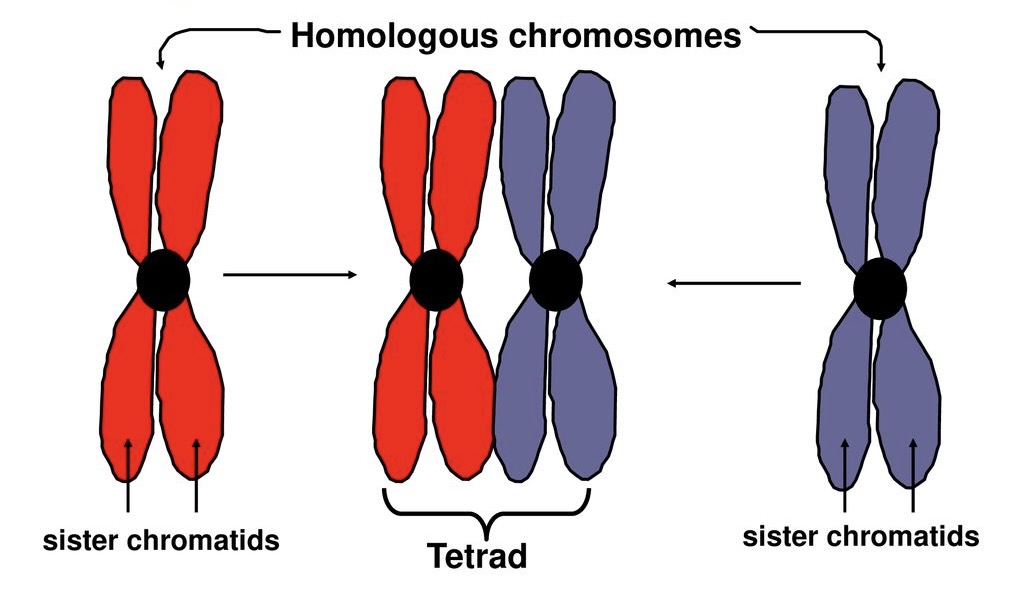
- %%Metaphase I%% - the homologous chromosome pairs are lined up along the middle of the cell by spindle fibers
- the arrangement mixes up the chromosomal combinations and creates genetic diversity
- %%Anaphase I%% - the paired homologous chromosomes separate from each other and move toward opposite poles of the cell; the sister chromatids remain together
- %%Telophase I%% - the nuclear membrane forms again in some species, spindle fibers disassemble, cell undergoes cytokinesis
- results in 2 cells that each have a unique combination of 23 duplicated chromosomes
%%Meiosis II%% - divides sister chromatids and results in unpaired chromosomes
applies to both cells created in meiosis I
there is no interphase or DNA replication between the two stages of meiosis
- %%Prophase II%% - the nuclear membrane and nucleolus breaks down, centrioles move to opposite poles, spindle fibers assemble
- %%Metaphase II%% - spindle fibers align the 23 chromosomes at the cell equator
- %%Anaphase II%% - sister chromatids are puled apart from each other and move to opposite poles of the cell
- %%Telophase II%% - nuclear membranes form around each set of chromosomes, spindle fibers break down, nucleolus reforms, cell undergoes cytokinesis
- results in 4 haploid cells with a combination of chromosomes (unpaired) from both parents
%%Key differences between meiosis and mitosis:%%
- %%meiosis%% - 2 cell divisions, mitosis - 1 cell division
- %%meiosis%% - homologous chromosomes (tetrads) pair up along the equator, mitosis - homologous chromosomes never pair
- %%meiosis%% - anaphase I, sister chromatids remain together, mitosis - anaphase, sister chromatids separate
- %%meiosis%% - results in haploid cells, mitosis - results in diploid cells
- %%meiosis%% - occurs in cells in sex organs for reproduction, mitosis - occurs in body cells for development, growth, and repair
Haploid cells are the end result of meiosis, however, are incapable of fertilization until they go through more changes
%%Gametogenesis%% - the production of gametes, which includes meiosis and other changes that produce a mature cell
final stages differ between the sexes
%%sperm%% cell (male gamete) is much smaller than the egg (female gamete)
- main contribution is DNA
- must swim so the ability to move is critical
- sperm formation starts with a round cell and ends by making a streamlined cell that can move quickly
- DNA is tightly packed and much of the cytoplasm is lost, resulting in a compact head
- the cell develops a flagellum and connecting neck packed with mitochondria that drive the cell
formation of egg is a complicated process
- begins before birth, inside the developing body of a female embryo and is not finished until it is fertilized by a sperm
- process includes active and inactivity
- gives DNA to embryo and contributes the organelles
- only one of four cell produced by each round of meiosis actually makes an egg, other cells produced by meiosis become polar bodies
- polar bodies - cells with little more than DNA that are are eventually broken down
- do not undergo meiosis II in many species
}}11-3 Mendel and Heredity}}
traits - distinguishing characteristics that are inherited
genetics - the study of biological inheritance patterns and variation in organisms
%%Gregor Mendel%% "Father of Genetics" established much of our understanding of genetics in the middle of the 1800s
He chose garden pea plants for his experiments because they reproduce quickly and he could control how they mate; in nature, the pea flower typically self-pollinates
If a line of plants has self-pollinated for long enough, that line becomes genetically uniform or purebred (true breeding)
- as a result, the offspring inherit all of the parent organisms's characteristics
Mendel mated plants with specific traits by removing the male part of flowers, preventing self-pollination and fertilizing female parts with pollen with sperm cells from a different plant, creating hybrids
- hybrids - offspring of crosses between different parents
Mendel started with purebreds so he knew that any variations in offspring resulted from his experiments
- He chose 7 "either-or" traits to follow: pea shape, pod shape, pod color, plant height, flower color, and flower position
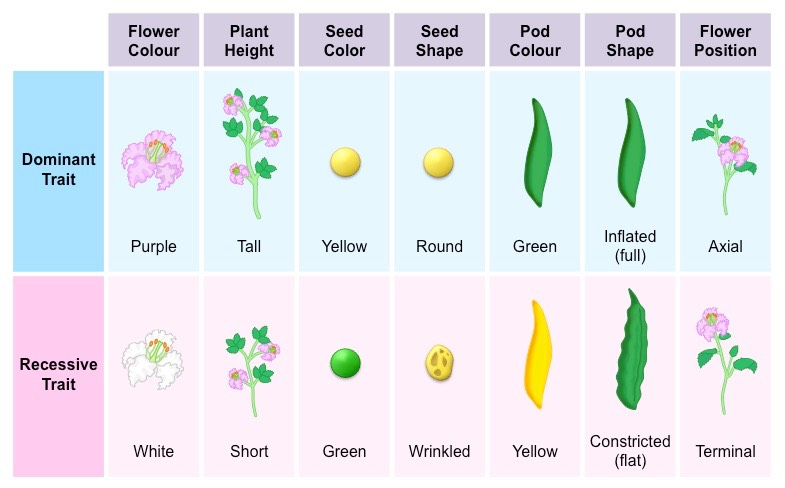
%%cross%% - the mating of two organisms
- e.g. Mendel crossed a purebred white flower pea plant with a purebred purple flower pea plant
- these plants are the parental (P) generation
- the resulting offspring are the first filial (F1) generation
- all had purple flowers
- the trait for white flowers seemed to disappear
- When Mendel allowed the F1 generation to self-fertilize, the resulting F2 generation produced both plants with purple flowers and plants with white flowers
- therefore, the trait for white flowers had not disappeared; it had been hidden, or masked
Mendel drew three important conclusions:
- traits are inherited as genes which provided an explanation for individual traits that persisted without being blended or diluted over generations
His other two key conclusions are called the %%law of segregation%% or Mendel's first law.
- organisms inherit two copies of each gene, one from each parent
- organisms donate only one copy of each gene in their gametes; the two copies of each gene segregate (separate) during gamete formation
}}11-4 Traits, Genes, and Alleles}}
gene - a piece of DNA that provides a set of instructions to a cell to make a certain protein
Each gene has a locus - a specific position on a pair of homologous chromosomes
- can be thought of like an "address"
allele - any of the alternative forms of a gene that may occur at a specific locus
- your cells have two alleles for each gene, one on each of the homologous chromosomes
- each parent gives one allele
- homozygous - two of the same alleles at a specific locus; identical to each other
- heterozygous - two different alleles at a specific locus
- homozygous/heterozygous visual
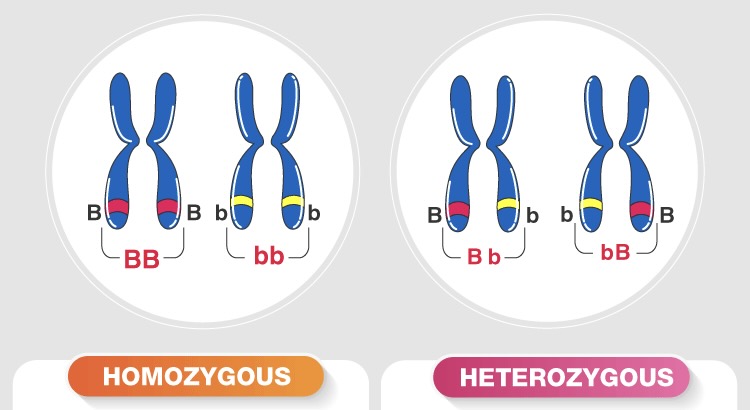
genome - all of an organism's genetic material
- everyone has a unique genome that determines all of your traits
genotype - refers to the genetic makeup of a specific set of genes
- e.g. the genotype of a pea plant includes both of the genes that code for flower color, even if one of the genes is masked
phenotype - the physical characteristics of an individual organism
- e.g. a pea plant with purple flowers has a phenotype fo purple flowers, the hidden gene for white flowers does not matter to the phenotype
Which allele will be expressed in a heterozygous organism — one allele may be dominant over another allele (Mendel's principle of dominance)
- %%dominant allele%% - the allele that is expressed when two different alleles or two dominant alleles are present
- %%recessive allele%% - the allele that is expressed only when two copies are present
- In Mendel's experiments, the allele for purple flowers was dominant to the allele for white flowers
}}11-5 Probability and Genetic Variation}}
Punnet square - a grid system for predicting all possible genotypes resulting from a cross
- fertilization restores the diploid number in the resulting offspring
- each grid box has two alleles, one from each parent
monohybrid cross (single factor cross) - crosses that examine the inheritance of only one specific trait
testcross - a cross between an organism with an unknown genotype and an organism with the recessive phenotype
- the offspring shows whether the organism with the unknown genotype is heterozygous or homozygous dominant
dihybrid cross - crosses that examine the inheritance of two different traits
- Mendel found an approximate 9:3:3:1 phenotypic ratio in the F2 generation
- he realized that one trait did not affect the presence of another trait
law of independent assortment - allele pairs separate independently of each other during meiosis (gamete formation)
- different traits appear to be inherited separately
probability - the likelihood that a particular event will happen; predicts average
crossing over - the exchange of chromosome segments between homologous chromosomes during prophase I; occurs during meiosis and helps create even greater genetic variation
recombination - any mixing of parental alleles
genetic linkage - genes located close together tend to be inherited together; genes far apart are more likely to assort independently
- first described by William Bateson and R.C. Punnett
- their results differed from the 9:3:3:1 phenotype ratios that Mendel observed
How could genes be linked and still follow Mendel's law of independent assortment?
- Thomas Hunt Morgan worked with fruit flies and found the answer
- his results did not always follow 9:3:3:1
- some traits appeared to be inherited together — linked traits
%%the closer two genes are, the more likely it is that they will be inherited together%%
%%the farther apart two genes are, the more likely it is that they will be separated during meiosis%%
linkage maps - maps of the relative locations, or loci, of genes on a chromosome
- one map unit is equal to one crossover for each 100 offspring
}}11-6 Extending Mendelian Genetics}}
Many factors affect phenotype, including the specific chromosome upon which a gene is located
Gene expression is often related to whether a gene is located on an autosome or sex chromosome
- Many human genetic disorders are also caused by autosomal genes
- Some are caused by recessive alleles
- 2 copies of the recessive allele must be preset for a person to have the disorder
- someone who is homozygous for the recessive allele will have the disease
- someone who is heterozygous for the alleles will not have the disease, but is a carrier
- %%carrier%% - does not show disease symptoms but can pass on the disease-causing allele
- dominant genetic disorders are less common than recessive disorders
- ex. Huntington's disease - damages the nervous system and appears during adulthood
%%sex-linked genes%% - genes that are located on the sex chromosomes
- Y chromosome genes are responsible for the development of the male offspring
- X chromosome has more influence over phenotype
- in males there are no second copies of sex-linked genes to mask the effect of another allele
- even if all the alleles of sex-linked genes in a male are recessive, they will be expressed
%%Barr bodies%% - In females, 1 of the 2 X chromosomes is randomly turned by X chromosome inactivation
Not all traits show simple dominant and recessive patters (Mendelian inheritance) and many genes have more than 2 alleles:
incomplete dominance - neither allele is completely dominant or completely recessive
- ex. a homozygous red flowered plant is crossed with a homozygous white flowered plant and the result is a pink flowered plant
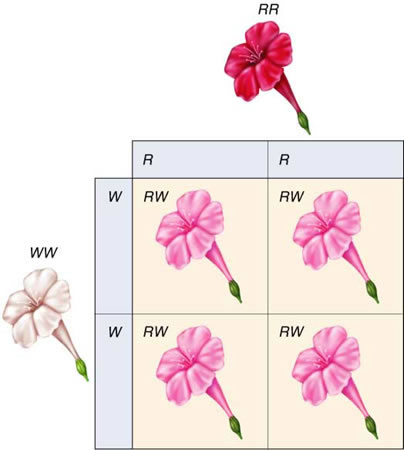
codominance - where both alleles of a gene are expressed completely
- ex. chickens with black feathers crossed with chickens with white feathers produce chickens with black and white speckled feathers
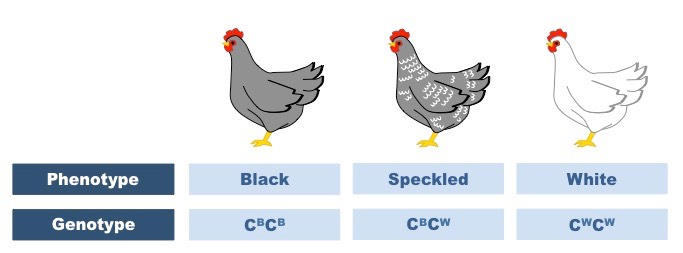
multiple alleles - genes that have more than two possible alleles that can be inherited
- ex. blood type in humans is the result of multiple alleles
polygenic traits - two or more genes interact to influence the phenotype
- ex. human skin color is the result of four genes that interact to produce a continuous range of colors
- human eye color
}}11-7 Human Genetics, Pedigrees, and Karyotypes}}
- many genetic disorders, such as Huntington's disease, hemophilia, and Duchesne's muscular dystrophy are caused by single genes that follow a dominant-recessive patter
- some genetic disorders are caused by autosomal genes
- a carrier of an autosomal disorder does not show the disease by can pass on the disease-causing allele
- males and females can be carriers of an autosomal disorder
- only females can be carriers of sex-linked disorders
- several genetic disorders are caused by genes on the X chromosome
- males have an XY genotype, so if they have an allele for a disorder located on the X chromosome, they will not have a second, normal allele to mask it
- there are no male carriers of sex-linked disorders
- the likelihood of inheriting a sex-linked disorder depends both on the sex of the child and which parent carries the disorder-causing allele
- if only the mother has the alleles and is a carrier, a child has a 50% chance of inheriting the allele
- a daughter who inherits it will not show the phenotype, but a son will
%%pedigree%% - a chart that can help trace the phenotypes and genotypes in a family to determine whether people carry recessive alleles
- boxes represent males and circles represent females
- if approximately the same number of males and females have the phenotype, then the gene is most likely on an autosome
- if the phenotype is much more common in males, then the gene is likely on the X chromosome
- It is easy to trace genotypes through a pedigree when you know that you are dealing with a trait controlled by an autosomal gene
- a person who does not show the phenotype must have a homozygous recessive genotype
- any other genotype (heterozygous or homozygous dominant) would produce the phenotype
%%nondisjunction%% - when the members of a chromosome pair fail to separate → one gamete receives two of the same type of chromosomes and another gamete receives no copy of that chromosome
- the other chromosomes are distributed normally
- if the gamete produced by nondisjunction unties with a normal gamete during fertilization, the result is a zygote with an abnormal number of chromosomes
%%trisomy%% - when the zygote gets three copies of a chromosome
- ex. Down's Syndrome - 3 copies of #21
%%monosomy%% X - Turner's Syndrome, occurs when a zygote gets only 1 X chromosome